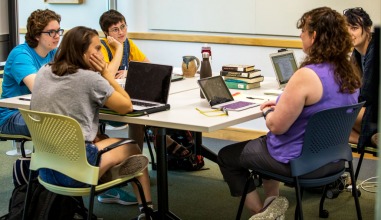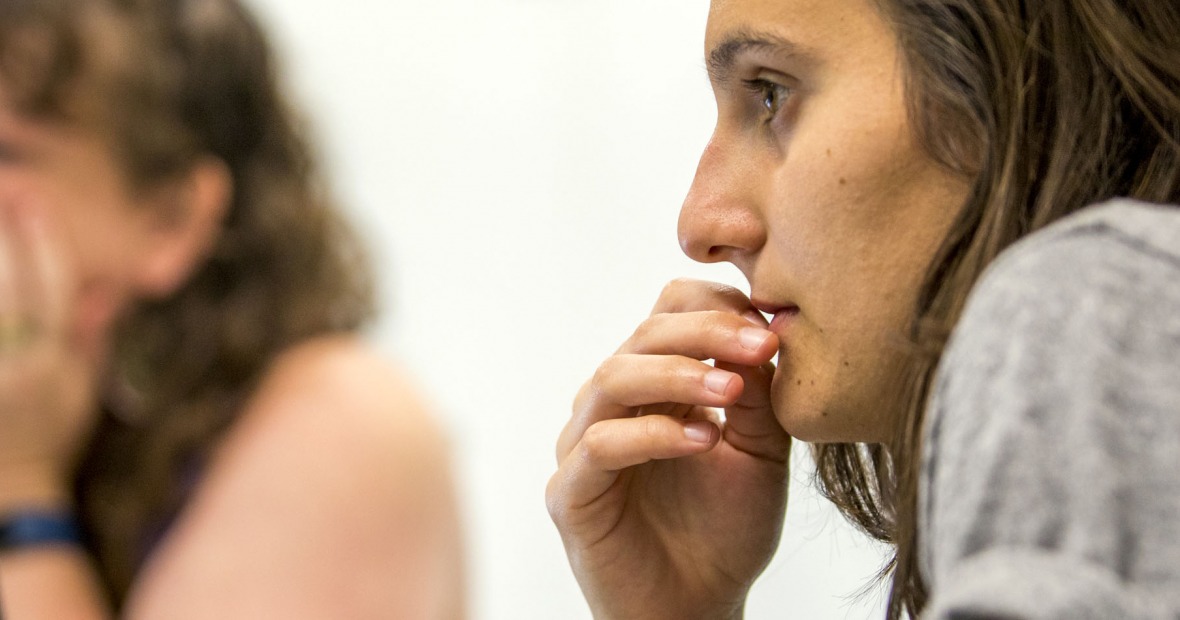Between the Question and the Answer
Monogamous relationships — in which an individual has one intimate, romantic, or sexual partner — are seen as the norm in the United States. In contrast, are nonmonogamous relationships solely private acts of individuals or something more, such as a social movement?

To answer that question, Emma Kalkowski-Farrand ’19 and Anna Billy ’20 spent nearly three months searching through primary and secondary sources from the 1800s through today. They made up half of the student group — rounded out by Paige Oamek ’20 and Maddie Birchfield ’19 — that spent last summer researching nonmonogamy as part of a Mentored Advanced Project (MAP) led by Carolyn Lewis, associate professor of history.
Through MAPs, students do deep, focused research, guided by a faculty member, to discover new knowledge and develop the skills to confidently pursue their own ideas. We chatted with Emma and Anna to learn more about their project and what they felt they got out of it.
What was the goal of this MAP?
Anna: The basis of Professor Lewis’ MAP was to submit a document project to the Women and Social Movements database website in hopes of determining whether nonmonogamy is a social movement. Each student dove into a more specific sect of nonmonogamy, such as infidelity or group marriage, as a way to cover a wide breadth of work.
Emma: We began by finding sources individually and wrote little explanations of what they were and what their significance was. Then we met up and read over each other’s and helped to edit everyone’s together. We then moved on to writing the prospectus, which explained our research and argued why this project should be included in the Women and Social Movements database. We each wrote parts describing our sections, then came together, edited, and determined how to make it flow together.
And what was the focus of your individual research?
Emma: My topic was adultery so I looked at various famous scandals involving adultery, court cases, magazine articles, and even books that revealed attitudes towards adultery in a specific time.
Anna: My research focused on single mothers of color and their experience as well as the contemporary polyamory movement — in which individuals have more than one romantic or sexual partner.
But even though you pursued separate topics for the majority of the summer, there were still regular opportunities for collaboration.
Emma: We met up about once or twice a week to discuss where each of us was at and help each other if we got stuck. We collaborated quite a bit, sharing sources, helping each other talk through ideas and figure out how to proceed.
Anna: Because each student’s research was connected in one way or another, it was imperative to keep in contact and share documents or resources we had found during the week. For example, I found an article that did not serve the purpose for what I was researching but worked really well for another student’s focus on polyamory and social class. I shared the article with the student and it ended up making it into the document project and informing a large chunk of primary source documents in the final draft of the project.
What did you find most challenging about either the subject matter or the overall experience?
Emma: Probably the most challenging part was reading through old divorce cases. In fault-based divorces, one party has to be completely innocent while the other has to be overtly guilty of some wrong. So there were cases where women did not get divorces from physically abusive husbands because they had male friends that they talked to without their husband’s permission even if they had never been alone together so could not have committed adultery by the legal definition. So those cases were hard to get through.
Anna: Trying to find primary source documents was most certainly a challenge, but despite the frustrations, it was incredibly exciting. Using Ross Haenfler’s work in the sociology department to help frame nonmonogamy was the most rewarding aspect. Not only were we using academic work from our own circle, but it also helped us as a group determine the direction of our project. I felt as though once sitting down to discuss social movements with Ross our project became a streamlined and clear-cut process.
What impact has this experience had on you?
Anna: I feel like I am more equipped to conduct research on my own. I felt very lost for the first couple weeks but through Professor Lewis’ guidance and support from my peers I am confident in my ability to set out on a project on my own.
Emma: Well, I learned a lot more about adultery throughout history then I ever thought I would. I also gained more experience with doing more independent research, determining my own direction, finding my own sources, and reaching my own conclusions and then coming back together with a group and working with them to make my research and theirs the best it could be.
One last question. Is nonmonogamy a social movement?
Anna: I think our prospectus makes a compelling case for why nonmonogamy can be classified as a social movement.
Emma Kalkowski-Farrand ’19 is a double major in gender, women’s, and sexuality studies (GWSS) and philosophy. Anna Billy ’20 is a GWSS and English double major.

